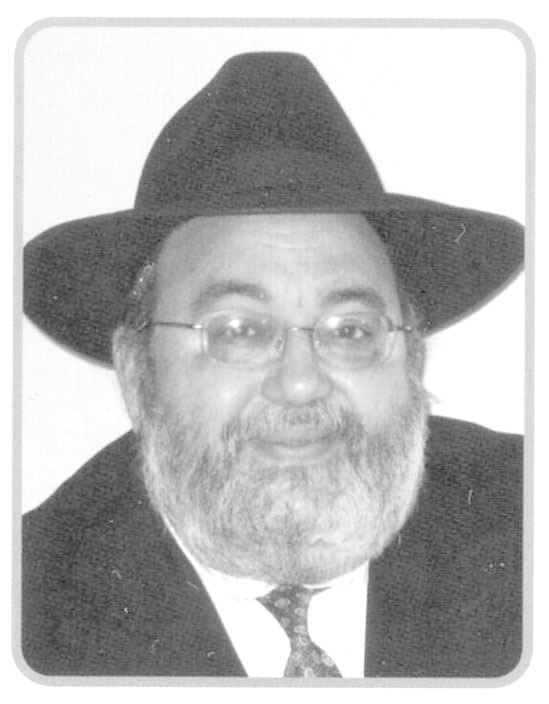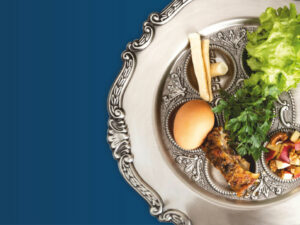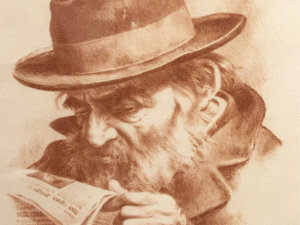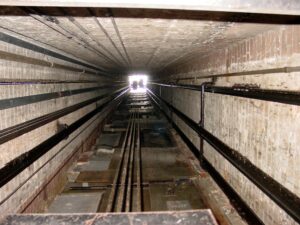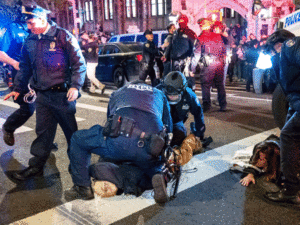The rosh yeshiva was now in a very uncomfortable position. On the one hand, how could he eat the food having heard this information? On the other hand, this was lashon hara and from a non-Jew. He looked into the matter and what he found was quite amusing. Yes, the woman was absolutely right. The meat was indeed not prepared like they did it in the old country with thorough salting and washing, but for good reason. Because unlike in the olden days, it was already done at the store by competent butchers. The old Polish woman was behind the times.
How many of you remember the good old-fashioned butcher shops with the sign on the window stating “Bosor Kosher”? I fondly remember going there with my mother tichyeh and playing with the fistfuls of saw dust from the floor. In the window were slaughtered chickens hanging from hooks by their throats, and you could see the butcher cutting large chunks of meat and bones with a saw machine. When ordering a cut of meat, the butcher would cut it with a hacking knife. If you ordered hockfleish, hamburger meat, he would grind it in a machine right before your eyes. Women kashered their own meat with a special thick kashering salt.
Today, children observing their mothers buying meat in neat plastic-wrapped containers haven’t a clue how much preparation goes into making the meat fit for consumption. But even in our day, we weren’t aware of the tedious preparation that went on in the butcher’s back room, the trabering, which brings us to the title of this article.
For those of you who were wondering what a sinew is and to where it was displaced, it is the gid hanosheh, a part of the animal that must be removed, for it is forbidden to eat. There is a machlokes in the Gemara (Pesachim 22a) as to whether yeish begidin benosein ta’am – does the sinew have a taste or not? It is a question with halachic ramifications, but one thing is for sure: There are numerous tastes and lessons to be learned from this prohibition.
It was one of the most dramatic confrontations in history, and it would be a harbinger for the survival of Klal Yisroel throughout the ages: “And Yaakov was left alone and a man wrestled with him until the break of dawn. When he perceived that he could not overcome him, he struck the socket of his hip, and Yaakov’s hip socket was dislocated as he wrestled with him. And the sun rose for him as he passed Penuel and he was limping on his hip. Therefore, the Bnei Yisroel are not to eat the gid hanosheh, the displaced sinew, to this day, because he struck Yaakov’s hip socket on the displaced sinew” (Bereishis 32:25-33).
The Torah is long and vast, and we cannot perceive the full depth of the reasons behind the mitzvos. But here we are told explicitly that the prohibition of gid hanosheh is a reminder of this wrestling match between Yaakov and the mysterious combatant. Chazal do tell us that this man was the guardian angel of Eisav in the guise of a man. What lessons can we derive from the prohibition of the displaced sinew?
The Sefer Hachinuch (mitzvah 3) explains that this encounter was a portent of the future. The sar shel Eisav attempted to uproot Yaakov Avinu from this world but was unable to. So, in a last ditch effort, he wounded him by dislocating his thigh. Refraining from eating the gid hanosheh symbolizes our avoiding pain at the hands of Eisav. As we say in the Haggadah, “In every generation they stand up against us to destroy us. And Hakadosh Boruch Hu saves us from their hands.” Yes, there will be pain at the hands of Eisav’s offspring. Yes, there will be bloodshed and heartache. But just as Yaakov was healed when the sun shone upon him, so too, ultimately, we, his progeny, will prevail and be healed from the pain when the rays of Moshiach shine upon us.
The Maggid of Minsk sees a different point in this encounter. How can we say that in this battle Yaakov was victorious when the Torah tells us that he was wounded and went away limping? Is that called a victory?
The Maggid explains that when two parties are engaged in a conflict, how the winner is determined depends upon the nature of the contest. If it is a physical brawl, with each contestant trying to suppress the other with his strength, then the one who strikes the last blow, subduing his opponent, is the victor. If, on the other hand, it is a debate, with each side trying to advance his position with logic and proofs, then victory is attained when one of the debaters brings evidence for his point of view that cannot be refuted and the opponent is forced to yield to his position.
However, if two people are engaged in a debate and one of the contestants answers the solid reasoning of his friend with physical blows that incapacitate him, then it is clear that the aggressor has been defeated, because since he cannot advance his cause with reason and rhetoric, he resorts to the use of violence.
This is what we must remember when we gouge out the gid hanosheh. The fight between Yaakov and Eisav was not merely a physical one. “Vayei’ovek ish imo.” Vayei’ovek comes from the word avak, dust. Chazal tell us that in their struggle, they kicked up dust all the way to the Heavenly Throne (Chullin 91a). This was an ideological battle, with the malach trying to corrupt Yaakov with unclean thoughts and heretical ideas. Seeing that all of his efforts were futile, he had to resort to physically hurting Yaakov. This is the greatest sign of Yaakov’s victory – that our hashkafah and our way of life are unimpeachable, and despite suffering from our assailants throughout the ages, in the end our cause will be vindicated.
Yaakov being hurt despite his decisive victory was in fact what happened to the Ramban in the thirteenth century. In the year 1263, the church in Spain orchestrated a debate between Christians and Jews, to take place before King James I of Aragon. The main instigator for this was a meshumad named Pablo Christiani (Friar Paul), who claimed that he could prove the superiority of Christianity from the Talmud itself. So confident of his ability was he that he insisted that none other than the Ramban oppose him to defend the Jewish cause.
The Ramban understood that this was a no-win situation, for even if he would be victorious, the opposition would just vent more anger against the Jews. Under the circumstances, he had no choice but to participate. With his sheer brilliance, his incomparable knowledge and gift of reasoning, he routed his foes.
The debate was never officially concluded, but rather suspended. King James was forced to admit to the Ramban, “I have never seen a man defend a wrong cause so well.” He also contributed three hundred gold coins to the Ramban’s yeshiva and did something unheard of in those times: The king visited the shul on the Shabbos after the debate and addressed the tzibbur.
Just as the Ramban feared, though, there were repercussions of his victory. The church, unable to best him, reenacted the dislocation of the sinew. They persecuted the Ramban and his family, forcing them to flee the country in 1267. They intensified their efforts to convert the Jewish population in Spain to their religion. Like Yaakov Avinu, the Ramban continued to flourish, moving to Eretz Yisroel, reestablishing the Jewish community in Yerushalayim and founding the famous Ramban Shul there.
There is another lesson to be learned from the gid hanosheh. It signifies a pain much greater than a displaced limb. Chazal say that the striking of the kaf yerech of Yaakov represents the yotzei yerech, the progeny of Yaakov. In future generations, there will be children who forsake the holy legacy of their forefathers and wander off to other paths. Who can fathom the pain of a father and mother whose child has gone astray, the deep anguish they feel, the sleepless nights wondering where their child is hanging out? And there is the sense of guilt, blaming themselves. If only we would have done this or that differently… If only we would have read more books on chinuch. If only…
But the incontrovertible truth is that sometimes all of the books and all of the niceties cannot prevent this tragedy. How often do master mechanchim and mechanchos who guide others in these matters also suffer from this agony? This is not unique to our generation. It was the case throughout our history. The holy Chofetz Chaim was once extolling the virtues of a certain adam gadol, when someone commented rudely and with great insensitivity, “But there is a saying that the apple doesn’t fall far from the tree and this rov’s son went off the derech.”
The Chofetz Chaim answered, “When doesn’t the apple fall far from the tree? On a calm, sunny day. But on a stormy day, when there are ferocious winds blowing, the apple can indeed fall easily and be blown far away. When there are foreign winds of heresy and alien ideologies blowing all around, then it is not hard for one to go astray.”
It is much the same nowadays. There is a spiritual disease in the air, and some people are more susceptible to catching it than others. Of course we must try our utmost to be mechanech our children in the best way possible, but sometimes, despite all of our efforts, the road can be a very rocky one.
However, we should take heart. The limb was not cut off or completely separated, nor did it totally dry up. In the end, it was returned to its place and Yaakov was healed. Hashem guarantees that those children who wandered off will eventually return. Like the gid hanosheh, they are never totally detached, as the pintele Yid, the spark of their neshamos, still glows deep within them.
Furthermore, says the Chofetz Chaim, the thigh wasn’t dislocated on its own, but rather by a blow from Eisav’s malach. This is a limud zechus for those who have wandered off. It did not come from their own essence, but rather from the power of Eisav, who is Samael, the Soton, the power behind our subjugation in golus. We are promised that in the end, “…all of your children will be students of Hashem and your children’s peace will be abundant” (Yeshayah 54:14).
Finally, the thigh is the support of a person’s body. The Zohar Hakadosh says that when the sar shel Eisav sees that he cannot defeat Yaakov and those who sit in the tents of Torah, he influences those who financially support them to invest their money in other places. The Chofetz Chaim said in the name of his son-in-law, Rav Tzvi Hirsh Levinson, that this indicates that at the dawn of Moshiach, mosdos haTorah will suffer from lack of funding. But like their forbear Yaakov, they will continue to move on, albeit struggling, until the rays of Moshiach shine upon us.
After World War II, with the Jewish nation left in shambles, Hashem sent us a supporter who was a sterling example for others of how much one must invest in supporting Torah. Reb Moshe Reichmann zt”l and ybl”c his brothers worked hard at returning the displaced sinew to its proper place. For this we are most grateful.
